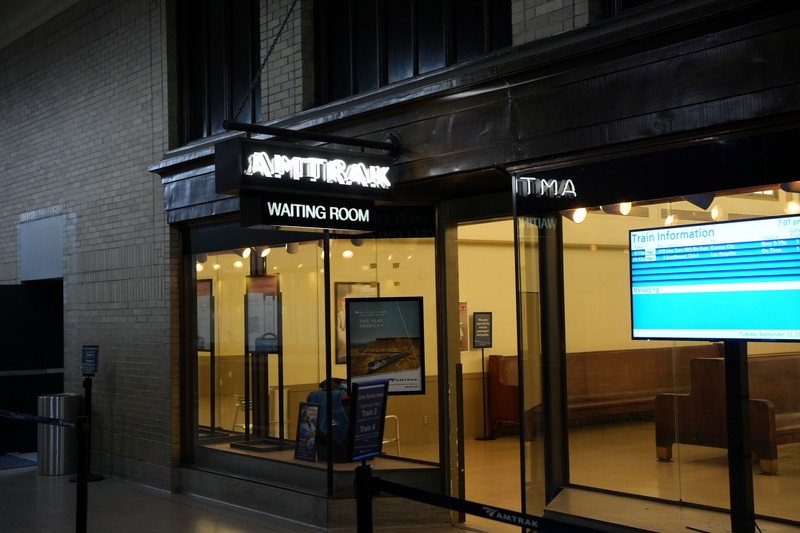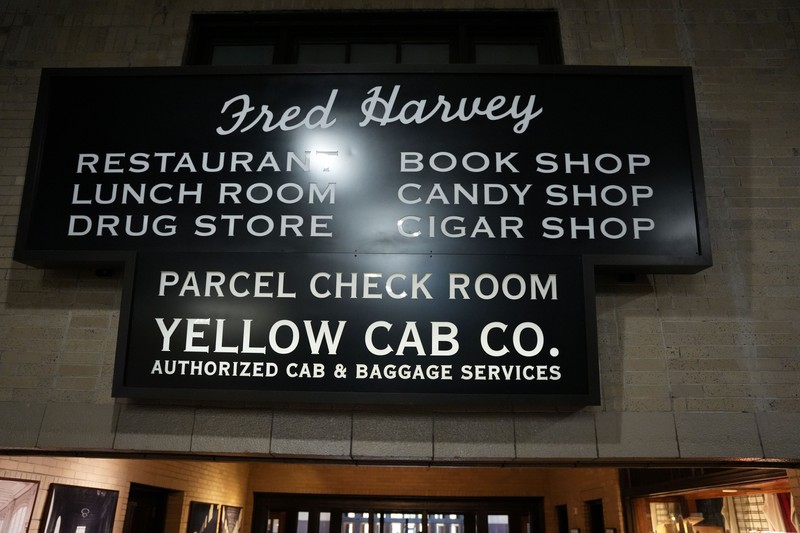Fred Harvey's Sign, Haverty Railroad Gallery, and Railroad China Collection
Introduction
Text-to-speech Audio
Union Station continues to serve rail passengers via Amtrak, which returned to Union Station after departing in 1985. Next to the Amtrak waiting room is a historic sign for Fred Harvey's restaurant chain which once operated throughout the region. Perhaps the first true chain restaurant in American history, Fred Harvey's railroad depots thrived because they met a need in an era when travelers had few dining options. Fred Harvey pioneered a model that served travelers quickly and efficiently, and his methods were soon repeated at depots along the Atchison, Topeka, & Santa Fe Railroad. Nearbye are a display of custom flatware from the individual likes and the Haverty Railroad Gallery, both displaying images and items from a moment in American History when rail travel was an elegant, sophisticated, and elevated means of transportation.
Images


Haverty Railroad Gallery

Haverty Railroad Gallery

The collection of china and silverware from various railroads that served Kansas City is located next to Pierpont's Restaurant.

The collection of china and silverware from various railroads that served Kansas City is located next to Pierpont's Restaurant.

The collection of china and silverware from various railroads that served Kansas City is located next to Pierpont's Restaurant.

The collection of china and silverware from various railroads that served Kansas City is located next to Pierpont's Restaurant.

The collection of china and silverware from various railroads that served Kansas City is located next to Pierpont's Restaurant.



The twelve rail lines which came together to create Union Station

Backstory and Context
Text-to-speech Audio
Fred Harvey's Sign
The sign from Fred Harvey’s original Union Station location hangs inside the Amtrak waiting room just off the Grand Hall. Harvey, a forefather of the chain restaurant, had one of his first location inside Union Station where Pierpont’s currently operates. Richard Nixon signed the Rail Passenger Service Act creating the National Railroad Passenger Corporation which would eventually become Amtrak. This originally incorporated eight private railroads under federal administration, but that number would grow to 20. When established, Amtrak operated six daily trains through Union Station. This number shows the scale of the decline of rail travel in the United States from the 200 daily trains through the station at its peak. In 1983 everything in Union Station Closed except Amtrak and The Lobster Pot restaurant. Amtrak continues business within an inflatable structure implemented to maintain climate control and avoid water from the leaking ceiling. Finally, in 1985, Amtrak left as well. After the renovation in 2002, passenger rail travel finally returned to Union Station with two Amtrak lines.
Haverty Railroad Gallery
The Haverty Railroad Gallery, located between the Amtrak waiting room and Pierpont’s, displays work by the artist Richard Allison of the twelve rail companies that joined together to form the Kansas City Terminal Railroad. The KCTR would fund the design and construction of Union Station by the architect Jarvis Hunt. It was this union of twelve railroads that led to the name Union Station, just as the coming together of six railroads led to Union Station's predecessor, Union Depot in the West Bottoms. The gallery is named in honor of Michael R. and Marlys Haverty, prominent supporters of Union Station.
Railroad China Collection
The Railroad China Collection, on display outside of Pierpont’s is mesmerizing. Looking at these pieces draws the viewer back into a time when there was an elegance in traveling. It is hard to imagine the level of detail and service that were provided to travelers riding these specific lines, but the craftwork, precision, and though put into the ceramics shown here is a great start.
